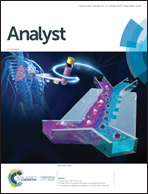A near infrared fluorescent probe for the detection and imaging of prolyl aminopeptidase activity in living cells†
Abstract
Prolyl aminopeptidase (PAP) is an important exopeptidase which might be a biomarker for pathogen infection and a potential therapeutic target. However, very few fluorescent probes have been developed for detecting PAP activity. Here we report the development of the first near infrared (NIR) turn-on fluorescent probe (NIR-PAP) for detecting and imaging PAP in living cells. The probe is prepared by reacting a cysteine–proline dipeptide with an acryloylated NIR fluorophore via a facile thiol-Michael addition reaction. NIR-PAP exhibits a dynamic response toward PAP in the range of 0.02–2.5 U mL−1 with an estimated limit of detection of 0.013 U mL−1. In vitro studies also reveal that the probe displays high specificity and robust responses toward PAP under physiological pH and temperature conditions. Moreover, NIR-PAP is successfully introduced to detect and differentiate PAP activity in four different cell lines via both confocal fluorescence imaging and flow cytometry. Therefore, our probe may hold great promise in diagnosing infectious diseases caused by pathogens and screening therapeutic drugs in vivo.



 Please wait while we load your content...
Please wait while we load your content...